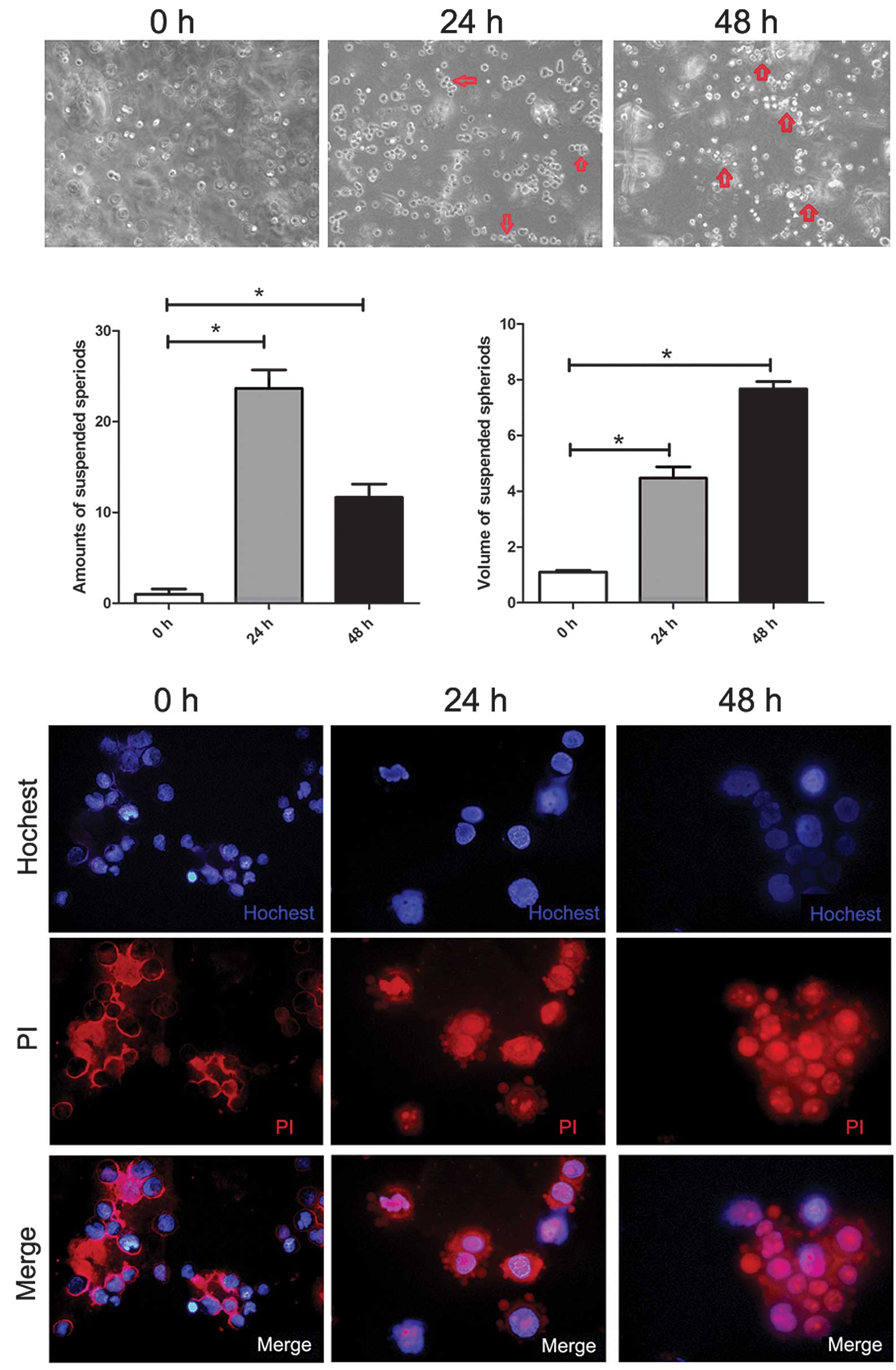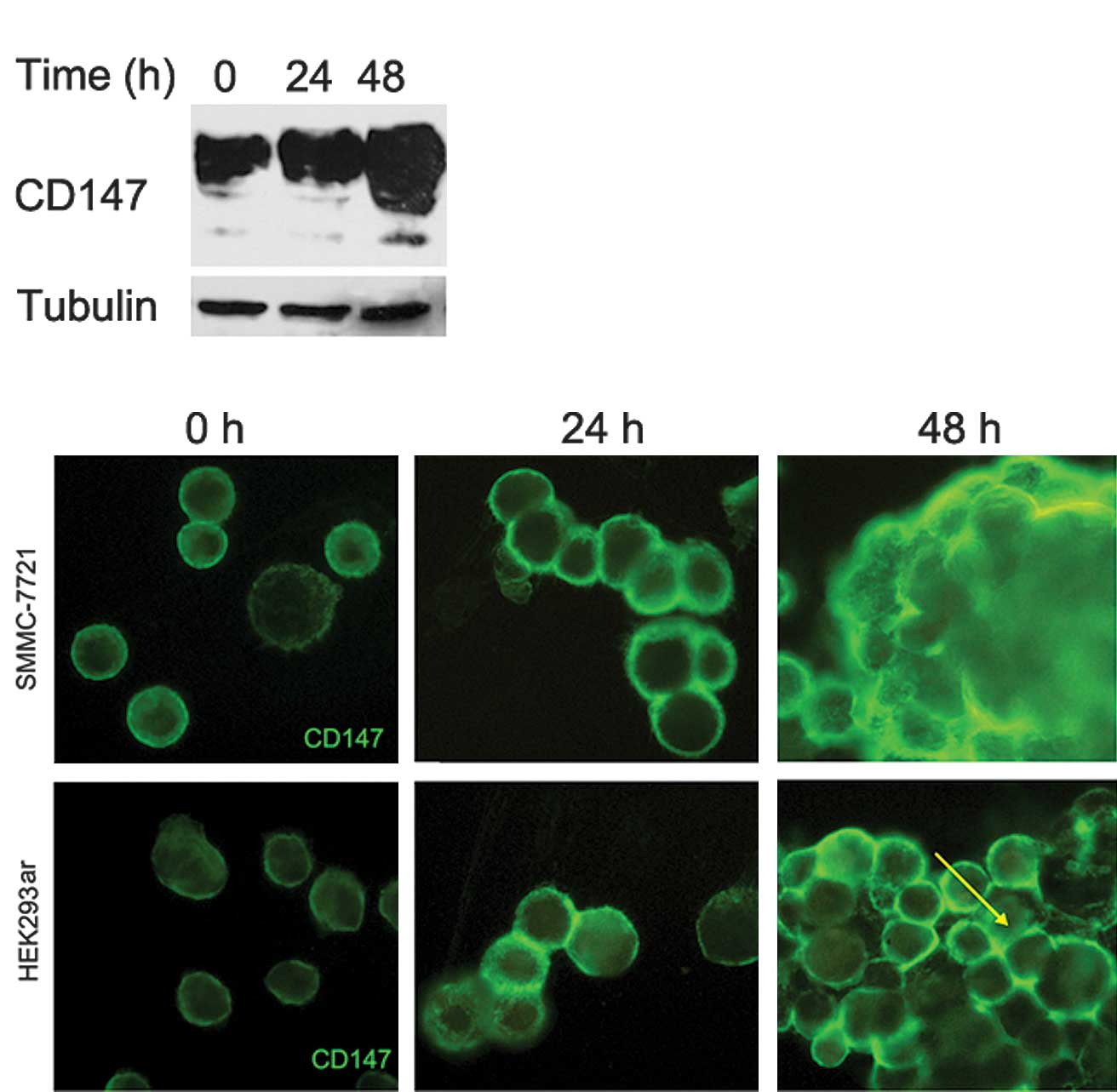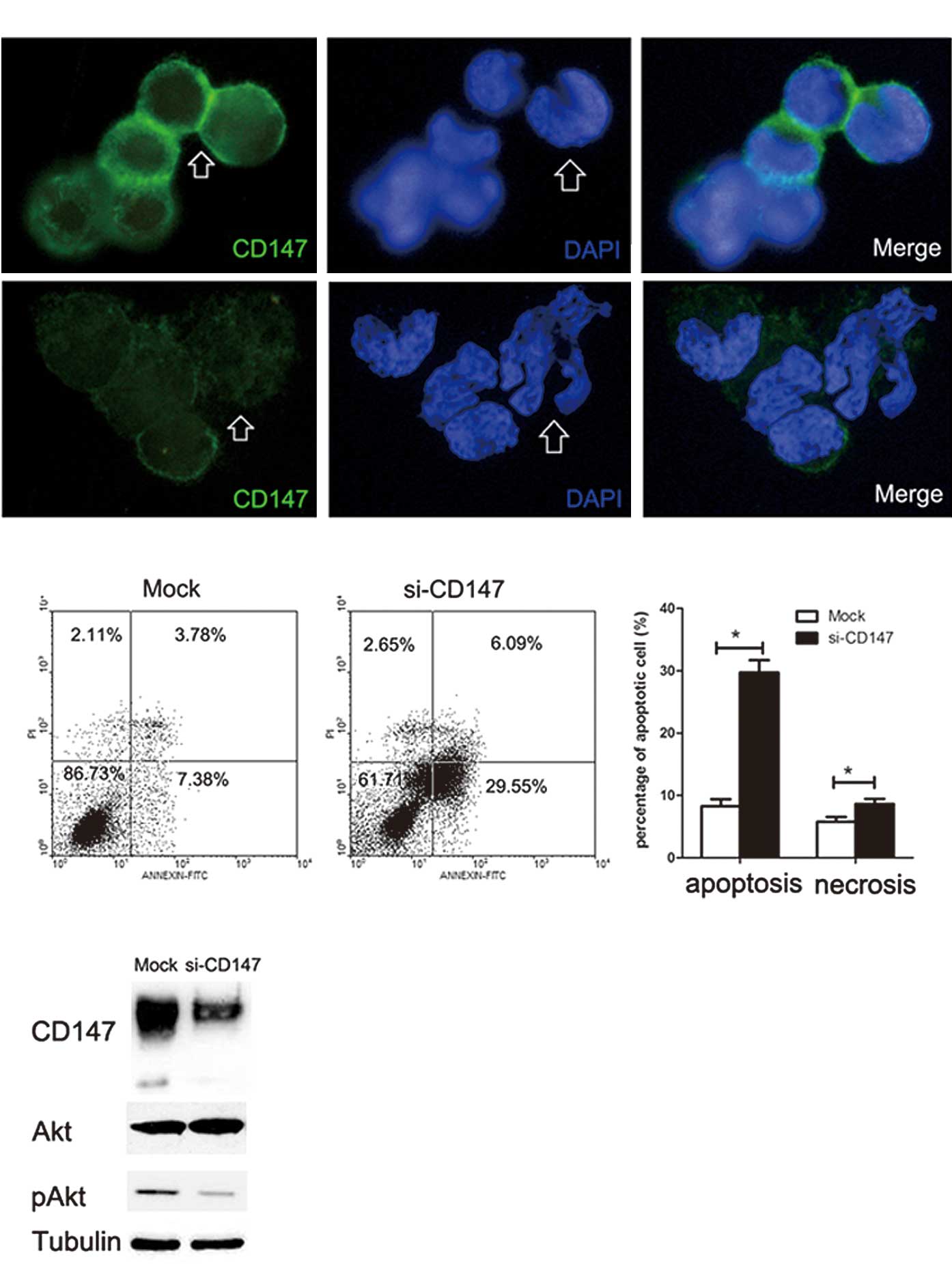|
1
|
Simpson CD, Anyiwe K and Schimmer AD:
Anoikis resistance and tumor metastasis. Cancer Lett. 272:177–185.
2008. View Article : Google Scholar : PubMed/NCBI
|
|
2
|
Frisch SM and Francis H: Disruption of
epithelial cell-matrix interactions induces apoptosis. J Cell Biol.
124:619–626. 1994. View Article : Google Scholar : PubMed/NCBI
|
|
3
|
Simpson CD, Mawji IA, Anyiwe K, et al:
Inhibition of the sodium potassium adenosine triphosphatase pump
sensitizes cancer cells to anoikis and prevents distant tumor
formation. Cancer Res. 69:2739–2747. 2009. View Article : Google Scholar
|
|
4
|
Taddei ML, Parri M, Angelucci A, et al:
EphA2 induces metastatic growth regulating amoeboid motility and
clonogenic potential in prostate carcinoma cells. Mol Cancer Res.
9:149–160. 2011. View Article : Google Scholar : PubMed/NCBI
|
|
5
|
Pongrakhananon V, Nimmannit U, Luanpitpong
S, Rojanasakul Y and Chanvorachote P: Curcumin sensitizes non-small
cell lung cancer cell anoikis through reactive oxygen
species-mediated Bcl-2 downregulation. Apoptosis. 15:574–585. 2010.
View Article : Google Scholar : PubMed/NCBI
|
|
6
|
Kumar P, Yadav A, Patel SN, et al:
Tetrathiomolybdate inhibits head and neck cancer metastasis by
decreasing tumor cell motility, invasiveness and by promoting tumor
cell anoikis. Mol Cancer. 9:2062010. View Article : Google Scholar : PubMed/NCBI
|
|
7
|
Aoudjit F and Vuori K: Matrix attachment
regulates Fas-induced apoptosis in endothelial cells: a role for
c-flip and implications for anoikis. J Cell Biol. 152:633–643.
2001. View Article : Google Scholar : PubMed/NCBI
|
|
8
|
Mawji IA, Simpson CD, Hurren R, et al:
Critical role for Fas-associated death domain-like
interleukin-1-converting enzyme-like inhibitory protein in anoikis
resistance and distant tumor formation. J Natl Cancer Inst.
99:811–822. 2007. View Article : Google Scholar
|
|
9
|
Smets FN, Chen Y, Wang LJ and Soriano HE:
Loss of cell anchorage triggers apoptosis (anoikis) in primary
mouse hepatocytes. Mol Genet Metab. 75:344–352. 2002. View Article : Google Scholar : PubMed/NCBI
|
|
10
|
Attwell S, Roskelley C and Dedhar S: The
integrin-linked kinase (ILK) suppresses anoikis. Oncogene.
19:3811–3815. 2000. View Article : Google Scholar : PubMed/NCBI
|
|
11
|
Terada LS and Nwariaku FE: Escaping
anoikis through ROS: ANGPTL4 controls integrin signaling through
Nox1. Cancer Cell. 19:297–299. 2011. View Article : Google Scholar : PubMed/NCBI
|
|
12
|
Rosen K, Rak J, Leung T, Dean NM, Kerbel
RS and Filmus J: Activated Ras prevents downregulation of Bcl-X(L)
triggered by detachment from the extracellular matrix. A mechanism
of Ras-induced resistance to anoikis in intestinal epithelial
cells. J Cell Biol. 149:447–456. 2000. View Article : Google Scholar : PubMed/NCBI
|
|
13
|
Boisvert-Adamo K and Aplin AE: B-RAF and
PI-3 kinase signaling protect melanoma cells from anoikis.
Oncogene. 25:4848–4856. 2006. View Article : Google Scholar : PubMed/NCBI
|
|
14
|
Frisch SM, Vuori K, Ruoslahti E and
Chan-Hui PY: Control of adhesion-dependent cell survival by focal
adhesion kinase. J Cell Biol. 134:793–799. 1996. View Article : Google Scholar : PubMed/NCBI
|
|
15
|
Zhao J, Zhang Y, Ithychanda SS, et al:
Migfilin interacts with Src and contributes to cell-matrix
adhesion-mediated survival signaling. J Biol Chem. 284:34308–34320.
2009. View Article : Google Scholar : PubMed/NCBI
|
|
16
|
Kang HG, Jenabi JM, Zhang J, et al:
E-cadherin cell-cell adhesion in ewing tumor cells mediates
suppression of anoikis through activation of the ErbB4 tyrosine
kinase. Cancer Res. 67:3094–3105. 2007. View Article : Google Scholar : PubMed/NCBI
|
|
17
|
Caudroy S, Polette M, Tournier JM, et al:
Expression of the extracellular matrix metalloproteinase inducer
(EMMPRIN) and the matrix metalloproteinase-2 in bronchopulmonary
and breast lesions. J Histochem Cytochem. 47:1575–1580. 1999.
View Article : Google Scholar : PubMed/NCBI
|
|
18
|
Pinheiro C, Longatto-Filho A, Simoes K, et
al: The prognostic value of CD147/EMMPRIN is associated with
monocarboxylate transporter 1 co-expression in gastric cancer. Eur
J Cancer. 45:2418–2424. 2009. View Article : Google Scholar : PubMed/NCBI
|
|
19
|
Guo H, Li R, Zucker S and Toole BP:
EMMPRIN (CD147), an inducer of matrix metalloproteinase synthesis,
also binds interstitial collagenase to the tumor cell surface.
Cancer Res. 60:888–891. 2000.PubMed/NCBI
|
|
20
|
Wu J, Ru NY, Zhang Y, et al: HAb18G/CD147
promotes epithelial-mesenchymal transition through TGF-beta
signaling and is transcriptionally regulated by Slug. Oncogene.
30:4410–4427. 2011. View Article : Google Scholar : PubMed/NCBI
|
|
21
|
Yang JM, O’Neill P, Jin W, et al:
Extracellular matrix metalloproteinase inducer (CD147) confers
resistance of breast cancer cells to Anoikis through inhibition of
Bim. J Biol Chem. 281:9719–9727. 2006. View Article : Google Scholar : PubMed/NCBI
|
|
22
|
Xu J, Shen ZY, Chen XG, et al: A
randomized controlled trial of Licartin for preventing hepatoma
recurrence after liver transplantation. Hepatology. 45:269–276.
2007. View Article : Google Scholar : PubMed/NCBI
|
|
23
|
Ma XK, Wang L, Li Y, et al: HAb18G/CD147
cell-cell contacts confer resistance of a HEK293 subpopulation to
anoikis in an E-cadherin-dependent manner. BMC Cell Biol.
11:272010. View Article : Google Scholar : PubMed/NCBI
|
|
24
|
Frisch SM: Evidence for a function of
death-receptor-related, death-domain-containing proteins in
anoikis. Curr Biol. 9:1047–1049. 1999. View Article : Google Scholar : PubMed/NCBI
|
|
25
|
Chen ZN: Significance and application of
anti-malignant hepatoma MAb HAb18 in radioimmunal diagnosis of
human hepatocellular carcinoma. Zhonghua Zhong Liu Za Zhi. 14:9–12.
1992.(In Chinese).
|
|
26
|
Gou X, Ru Q, Zhang H, et al: HAb18G/CD147
inhibits starvation-induced autophagy in human hepatoma cell
SMMC7721 with an involvement of Beclin 1 down-regulation. Cancer
Sci. 100:837–843. 2009. View Article : Google Scholar : PubMed/NCBI
|
|
27
|
Xu J, Xu HY, Zhang Q, et al: HAb18G/CD147
functions in invasion and metastasis of hepatocellular carcinoma.
Mol Cancer Res. 5:605–614. 2007. View Article : Google Scholar : PubMed/NCBI
|
|
28
|
Derksen PW, Braumuller TM, van der Burg E,
et al: Mammary-specific inactivation of E-cadherin and p53 impairs
functional gland development and leads to pleomorphic invasive
lobular carcinoma in mice. Dis Model Mech. 4:347–358. 2011.
View Article : Google Scholar : PubMed/NCBI
|
|
29
|
Singh AB, Sugimoto K and Harris RC:
Juxtacrine activation of epidermal growth factor (EGF) receptor by
membrane-anchored heparin-binding EGF-like growth factor protects
epithelial cells from anoikis while maintaining an epithelial
phenotype. J Biol Chem. 282:32890–32901. 2007. View Article : Google Scholar
|
|
30
|
Wu Y, Zuo J, Ji G, et al: Proapoptotic
function of integrin beta(3) in human hepatocellular carcinoma
cells. Clin Cancer Res. 15:60–69. 2009. View Article : Google Scholar : PubMed/NCBI
|
|
31
|
Feng Y, Wang LY, Cai T, et al:
All-trans-retinoic acid increased the expression of integrin
alpha5beta1 and induced ‘anoikis’ in SMMC-7721 hepatocarcinoma
cell. J Exp Clin Cancer Res. 20:429–438. 2001.PubMed/NCBI
|
|
32
|
McFall A, Ulku A, Lambert QT, Kusa A,
Rogers-Graham K and Der CJ: Oncogenic Ras blocks anoikis by
activation of a novel effector pathway independent of
phosphatidylinositol 3-kinase. Mol Cell Biol. 21:5488–5499. 2001.
View Article : Google Scholar : PubMed/NCBI
|
|
33
|
Isakoff SJ, Engelman JA, Irie HY, et al:
Breast cancer-associated PIK3CA mutations are oncogenic in mammary
epithelial cells. Cancer Res. 65:10992–11000. 2005. View Article : Google Scholar : PubMed/NCBI
|
|
34
|
Jiang K, Sun J, Cheng J, Djeu JY, Wei S
and Sebti S: Akt mediates Ras downregulation of RhoB, a suppressor
of transformation, invasion, and metastasis. Mol Cell Biol.
24:5565–5576. 2004. View Article : Google Scholar : PubMed/NCBI
|
|
35
|
Frisch SM and Ruoslahti E: Integrins and
anoikis. Curr Opin Cell Biol. 9:701–706. 1997. View Article : Google Scholar : PubMed/NCBI
|
|
36
|
Chen Y, Zhang H, Gou X, Horikawa Y, Xing J
and Chen Z: Upregulation of HAb18G/CD147 in activated human
umbilical vein endothelial cells enhances the angiogenesis. Cancer
Lett. 278:113–121. 2009. View Article : Google Scholar : PubMed/NCBI
|














